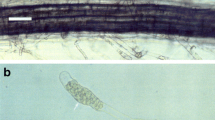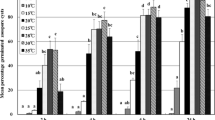Abstract
Quantitative differences among strains ofCorynebacterium sepedonicum (Spieck. and Kotth.) Skapt. and Burkh. (=Clavibacter michiganense subsp.sepedonicum) were distinguished in eggplant (Solanum melongena L. ‘Black Beauty’) bioassays with a simple leaf axil inoculation technique. Latent period of infection (time from inoculation to first appearance of symptoms) varied inversely with inoculum dose. Latent period of infection varied significantly among strains ofC. sepedonicum. Symptoms developed more rapidly in plants grown under controlled conditions in a growth chamber than those grown in a greenhouse. Plants treated with inoculum prepared from broth cultures exhibited symptoms more rapidly than those treated with inoculum grown on agar.
Resumen
Se encontraron diferencias cuantitativas entre las variantes de Corynebacterium sepedonicum (Spieck y Kotth) Skapt. y Burkh. (=clavibacter michiganense) subsp.sepedonicum, al efectuar pruebas biológicas utilizando la prueba simple de inoculación de la bacteria en la axila de las hojas de plantas de berenjena (Solanum melongena L. ‘Black Beauty’). El período latente de infección (tiempo transcurrido desde la inoculación hasta la aparición de los primeros síntomas) varió en relación inversa con la dosis del inóculo. El período latente de infección varió significativamente entres las variantes deC. sepedonicum. Los síntomas se desarrollaron más rápidamente en las plantas creciendo bajo condiciones controladas en una cámara de crecimiento que en aquellas que crecían en un invernadero.
Las plantas tratadas con inóculo obtenido en caldo de cultivo mostraron síntomas más rápidamente que aquellas tratadas con inóculo producido sobre agar.
Similar content being viewed by others
Literature Cited
Crowley, C.F. and S.H. De Boer. 1982. Nonpathogenic bacteria associated with potato stems cross-react withCorynebacterium sepedonicum antisera in immunofluorescence. Am Potato J 59:1–8.
Davis, M.J., A.G. Gillespie, Jr., A.K. Vidaver and R.W. Harris. 1984.Clavibacter: a new genus containing some phytopathogenic coryneform bacteria, includingClavibacter xyli subsp.xyli sp. nov., subsp. nov., andClavibacter xyli subsp.cyonodontis subsp. nov., pathogens that cause ratoon stunting disease of sugarcane and Bermudagrass stunting disease. Int J Syst Bacteriol 34:107–117.
De Boer, S.H. and R.J. Copeman. 1974. Endophytic bacterial flora inSolanum tuberosum and its significance in bacterial ring rot diagnosis. Can J Plant Sci 54:115–122.
De Boer, S.H. and R.J. Copeman. 1980. Bacterial ring rot testing with the indirect fluorescent antibody staining procedure. Am Potato J 57:457–465.
Ercolani, G.L. and J.E. Crosse. 1966. The growth ofPseudomonas phaseolicola and related plant pathogensin vivo. J Gen Microbiol 45:429–439.
Hoagland, D.R. and D.I. Arnon. 1938. The water culture method for growing plants without soil. Calif Agric Exp Stn Circ 347, 39 pp.
Lelliott, R.A. and P.W. Sellar. 1976. The detection of latent ring rot (Corynebacterium sepedonicum [Spieck. et Kotth.] Skapt. et Burkh.) in potato stocks. EPPO Bull 6:101–106.
Manzer, F. and S.A. Slack. 1979. Report of the pathology section committee on bacterial ring rot diagnosis. Am Potato J 56:551–555.
Meynell, G.G. and E.W. Meynell. 1958. The growth of microorganismsin vivo with particular reference to the relation between dose and latent period. J Hyg 56:323–346.
Raciot, H.N., D.B.O. Saville and I.L. Conners. 1938. Bacterial wilt and rot of potatoes— some suggestions for its detection, verification and control. Am Potato J 15:312–318.
Slack, S.A., A. Kelman and J.W. Perry. 1978. Comparison of three serodiagnostic assays for detection ofCorynebacterium sepedonicum. Phytopathology 69:186–189.
Slack, S.A., H.A. Sanford and F.E. Manzer. 1979. The latex agglutination test as a rapid serological assay forCorynebacterium sepedonicum. Am Potato J 56:441–446.
Vidaver, A.K. 1967. Synthetic and complex media for the rapid detection of fluorescence of phytopathogenic pseudomonads: Effect of the carbon source. Appl Microbiol 15:1523–1524.
Winstead, N.N. and A. Kelman. 1952. Inoculation techniques for evaluating resistance toPseudomonas solanacearum. Phytopathology 42:628–634.
Zeller, W. and Y. Xie. 1985. Studies of diagnosis of bacterial ring rot of potatoes I. Pathogenicity test in eggplants. Phytopathol Z 112:198–206.
Author information
Authors and Affiliations
Additional information
Former Graduate Research Assistant
This work was supported in part by the College of Agriculture and Life Sciences, University of Wisconsin-Madison, and by a grant from the Wisconsin Potato Industry Board.
Rights and permissions
About this article
Cite this article
Bishop, A.L., Slack, S.A. Effect of inoculum dose and preparation, strain variation, and plant growth conditions on the eggplant assay for bacterial ring rot. American Potato Journal 64, 227–234 (1987). https://doi.org/10.1007/BF02853560
Accepted:
Issue Date:
DOI: https://doi.org/10.1007/BF02853560




